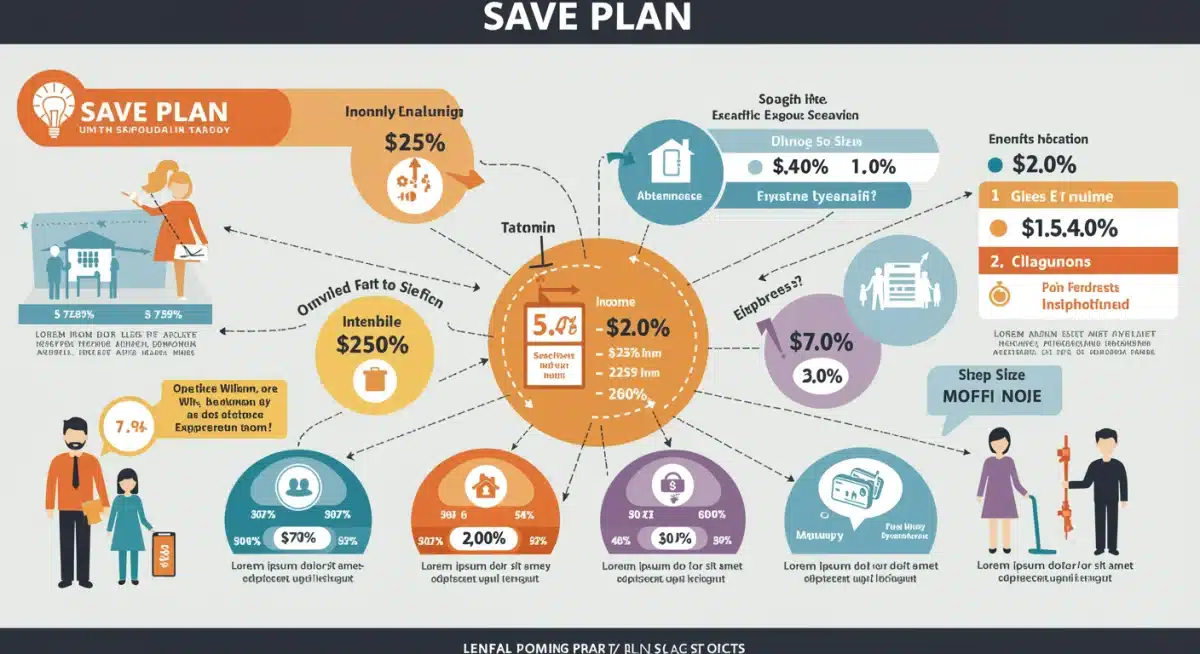New Federal Student Loan Repayment Plans 2025: Your Guide

The new federal student loan repayment plans for 2025 aim to simplify debt management, primarily through the SAVE Plan, offering income-driven options and potential for earlier loan forgiveness to alleviate financial burdens for millions of borrowers.
Navigating the complex world of student loan repayment can feel overwhelming, but understanding the new federal student loan repayment plans for 2025 is crucial for millions of Americans. These updated plans are designed to offer more manageable pathways out of debt, potentially saving borrowers significant amounts over the life of their loans. This guide will break down the key changes and provide practical solutions to help you make informed decisions about your financial future.
Understanding the Shift in Federal Student Loan Repayment Landscape
The federal student loan landscape is constantly evolving, and 2025 brings significant changes aimed at making repayment more accessible and equitable. These modifications reflect a broader effort to address the national student debt crisis, providing relief and clearer paths to financial stability for borrowers.
Historically, student loan repayment has been a source of anxiety for many, with complex options and often high monthly payments. The new plans, particularly the SAVE Plan, represent a paradigm shift, focusing on a borrower’s ability to pay rather than just the total debt owed. This approach is designed to prevent defaults and offer a safety net for those struggling with their payments.
Key Drivers Behind the Changes
- Addressing the rising cost of higher education and its impact on graduates.
- Reducing loan defaults and delinquencies across the country.
- Simplifying the often confusing array of repayment options.
- Providing more flexible and affordable payment structures.
These changes are not merely administrative tweaks; they are a direct response to the economic realities faced by millions of Americans. By understanding the rationale behind these shifts, borrowers can better appreciate the opportunities presented by the new repayment plans and how they can be leveraged for personal financial benefit. The goal is to create a more sustainable and less burdensome system for managing educational debt.
Deep Dive into the SAVE Plan: A Game Changer
The Saving on a Valuable Education (SAVE) Plan stands out as the most impactful new repayment option for 2025. It builds upon previous income-driven repayment (IDR) plans but introduces several enhancements designed to offer greater financial relief and flexibility to borrowers. Understanding its mechanics is essential for anyone seeking to lower their monthly payments or achieve earlier loan forgiveness.
At its core, the SAVE Plan calculates your monthly payment based on your discretionary income and family size, rather than your loan balance. This ensures that payments are affordable and adjusted to your current financial situation, offering a crucial safety net during periods of lower income or increased financial responsibility.
How the SAVE Plan Calculates Payments
The SAVE Plan significantly alters the discretionary income calculation. Instead of defining discretionary income as the amount exceeding 150% of the poverty line, the SAVE Plan raises this threshold to 225%. This means a larger portion of your income is protected, leading to lower monthly payments for most borrowers.
- For undergraduate loans, payments are capped at 5% of your discretionary income.
- For graduate loans, payments are capped at 10% of your discretionary income.
- For borrowers with both undergraduate and graduate loans, a weighted average between 5% and 10% is applied.
Another pivotal feature is the interest subsidy. Under the SAVE Plan, if your monthly payment doesn’t cover the accruing interest, the government covers the unpaid portion. This prevents your loan balance from growing due to unpaid interest, a common frustration with older IDR plans. This provision alone can save borrowers thousands of dollars and prevent the demoralizing experience of seeing their loan balance increase despite making payments.
Comparing SAVE with Other Income-Driven Repayment Options
While the SAVE Plan is a significant new development, it’s important to understand how it compares to existing income-driven repayment (IDR) options. Borrowers historically had several choices, such as Income-Based Repayment (IBR), Pay As You Earn (PAYE), and Income-Contingent Repayment (ICR). Each plan had its own rules regarding payment caps, discretionary income calculations, and forgiveness timelines.
The introduction of SAVE aims to streamline and improve upon these prior offerings, often making it the most advantageous option for many. However, eligibility and specific circumstances might still make other plans more suitable for a small subset of borrowers, especially those with very old loans or unique financial situations.
Key Differences and Advantages of SAVE
The most notable advantage of the SAVE Plan is its more generous definition of discretionary income, which directly translates to lower monthly payments for most participants. The interest subsidy is another critical differentiator, addressing a major flaw in previous IDR plans where unpaid interest could lead to ballooning loan balances, even for those making payments.
- Lower Payments: Higher discretionary income threshold (225% of poverty line vs. 150%).
- Interest Subsidy: Government covers unpaid interest, preventing balance growth.
- Shorter Forgiveness: Forgiveness for balances under $12,000 after 10 years of payments, with additional years for higher balances.
- Spousal Income Exclusion: For married borrowers filing separately, spousal income is excluded from payment calculations.
For many, particularly those with lower incomes or higher loan balances, the SAVE Plan offers a clear path to more affordable payments and a faster route to loan forgiveness. It represents a more borrower-centric approach to managing student debt, alleviating some of the long-standing criticisms of the federal student loan system.

Eligibility and Enrollment for the New Plans
Determining eligibility and understanding the enrollment process for the new federal student loan repayment plans in 2025 is vital for accessing their benefits. While the SAVE Plan is broadly accessible, specific criteria apply, and knowing how to navigate the application can save time and prevent delays in securing lower payments.
Generally, most federal student loans are eligible for income-driven repayment plans, including the new SAVE Plan. This includes Direct Loans and some FFEL Program loans. However, certain loan types, such as Parent PLUS loans, may require consolidation into a Direct Consolidation Loan to become eligible.
Who Qualifies for the SAVE Plan?
Eligibility for the SAVE Plan is primarily tied to having federal student loans and demonstrating a financial need based on your income and family size. There are no income caps to qualify, meaning even higher earners can enroll, though their payments might be higher.
- Eligible Loans: Direct Subsidized Loans, Direct Unsubsidized Loans, Direct PLUS Loans (for graduate or professional students), and Direct Consolidation Loans (that did not repay Parent PLUS loans).
- Income Requirements: Payments are calculated based on your discretionary income, so while there’s no income cap for eligibility, your income will directly impact your monthly payment amount.
- Application Process: You can apply or switch to the SAVE Plan through StudentAid.gov. You will need to provide information about your income and family size, which can be updated annually.
It’s crucial to re-certify your income and family size annually to ensure your payments remain accurate and affordable. Failing to re-certify could result in your payments reverting to a standard plan, potentially increasing your monthly obligation. Understanding these requirements and processes is key to successfully managing your student loan debt under the new framework.
Practical Strategies for Managing Your Student Loans in 2025
With the new federal student loan repayment plans in place for 2025, borrowers have more tools than ever to manage their debt effectively. Beyond simply enrolling in the SAVE Plan, adopting strategic approaches can further optimize your repayment journey, potentially leading to faster debt relief or greater financial flexibility.
Effective student loan management goes beyond just making minimum payments. It involves understanding your options, making informed decisions, and proactively engaging with your loan servicer. By taking a proactive stance, you can ensure your repayment strategy aligns with your broader financial goals.
Key Strategies for Success
- Assess Your Current Situation: Before making any decisions, thoroughly review your current loan types, balances, interest rates, and existing repayment plan.
- Utilize the Loan Simulator: The Federal Student Aid website (StudentAid.gov) offers a loan simulator tool. Use it to compare different repayment plans, including SAVE, and see how they impact your monthly payments and total cost over time.
- Stay Informed About Forgiveness Programs: Beyond IDR forgiveness, explore other programs like Public Service Loan Forgiveness (PSLF) if you work for a qualifying non-profit or government organization. The SAVE Plan can significantly benefit PSLF-eligible borrowers by lowering their monthly payments.
- Consider Consolidation: If you have multiple federal loans, consolidating them into a Direct Consolidation Loan can simplify repayment by combining them into a single loan with one monthly payment. This can also make certain loan types eligible for IDR plans they weren’t previously.
- Automate Payments: Setting up automatic payments can help you avoid missed payments and may even qualify you for a small interest rate reduction with some servicers.
Regularly reviewing your financial situation and repayment plan is a smart practice. Life changes, such as career advancements, marriage, or starting a family, can impact your income and household size, necessitating an update to your repayment plan to ensure it remains the most beneficial option.
Potential Challenges and How to Overcome Them
While the new federal student loan repayment plans for 2025 offer substantial benefits, borrowers may still encounter challenges. Understanding these potential hurdles and knowing how to address them can help ensure a smoother repayment process and prevent unnecessary stress or financial setbacks.
Common challenges often revolve around administrative complexities, understanding eligibility nuances, or adapting to changes in personal financial circumstances. Being prepared for these situations can make a significant difference in your ability to successfully manage your student loan debt.
Navigating Common Obstacles
- Administrative Delays: Application processing times can vary. Submit your applications and required documentation well in advance of deadlines. Keep copies of all submitted documents and communications with your servicer.
- Recertification Requirements: Forgetting to recertify your income and family size annually can lead to higher payments. Set reminders and proactively gather the necessary documentation (e.g., tax returns, pay stubs).
- Understanding Loan Types: Not all federal loans are eligible for all IDR plans. If you have FFEL Program loans, for example, you may need to consolidate them into a Direct Consolidation Loan to qualify for SAVE. Confirm your loan types on StudentAid.gov.
- Communicating with Your Servicer: Loan servicers can be a valuable resource. Don’t hesitate to contact them with questions or if you’re experiencing financial difficulty. Be persistent and clear in your communications.
- Avoiding Scams: Be wary of companies promising quick fixes or charging fees for services you can get for free from your loan servicer or StudentAid.gov. Always verify information with official sources.
Proactive engagement and diligent record-keeping are your best tools for overcoming potential challenges. Staying informed and utilizing official resources will empower you to navigate the repayment landscape successfully and ensure you are benefiting from the most advantageous plans available.
The Long-Term Impact of New Repayment Plans on Borrowers
The introduction of the new federal student loan repayment plans, particularly the SAVE Plan, for 2025 is poised to have a profound and lasting impact on millions of borrowers across the United States. These changes are not just about temporary relief; they represent a fundamental shift in how educational debt is managed and how it integrates into a borrower’s financial life.
For many, the promise of lower monthly payments and the interest subsidy means greater financial breathing room. This newfound flexibility can translate into tangible benefits, such as the ability to save for a down payment on a home, invest in retirement, or simply meet daily living expenses without the crushing burden of high student loan payments.
Broader Economic and Social Implications
Beyond individual financial well-being, the widespread adoption of these new plans could have broader economic and social benefits. Reduced financial stress for graduates might lead to increased consumer spending, greater participation in the housing market, and enhanced entrepreneurship, all contributing to economic growth.
- Improved Credit Scores: More manageable payments can lead to fewer delinquencies and defaults, positively impacting borrowers’ credit scores.
- Increased Financial Stability: The ability to plan for payments that are tied to income provides greater financial predictability and reduces anxiety.
- Reduced Wealth Gap: By preventing loan balances from growing and offering paths to forgiveness, these plans can help reduce the wealth gap, particularly for minority borrowers who often carry disproportionately higher student loan debt.
- Encouraging Higher Education: A more forgiving repayment system might encourage future generations to pursue higher education without the fear of insurmountable debt.
Ultimately, the new repayment plans aim to create a more sustainable system that supports both individual borrowers and the broader economy. By making student loan repayment a less formidable obstacle, these plans hope to unlock the economic potential of graduates, allowing them to contribute more fully to society and achieve their financial aspirations.
| Key Aspect | Brief Description |
|---|---|
| SAVE Plan | New income-driven plan with lower payments, interest subsidy, and faster forgiveness for many. |
| Discretionary Income | Calculated as income exceeding 225% of the poverty line under SAVE, leading to lower payments. |
| Interest Subsidy | Government covers unpaid monthly interest under SAVE, preventing loan balance growth. |
| Forgiveness Timelines | As short as 10 years for original balances under $12,000 under the SAVE Plan. |
Frequently Asked Questions About 2025 Student Loan Plans
The primary benefit of the SAVE Plan is its significantly lower monthly payments due to a more generous discretionary income calculation. Additionally, it prevents your loan balance from growing due to unpaid interest, as the government covers any interest not met by your payment.
Most federal student loans, including Direct Subsidized, Unsubsidized, and graduate PLUS loans, are eligible. FFEL Program loans may become eligible if consolidated into a Direct Consolidation Loan. Parent PLUS loans, however, are not directly eligible, even after consolidation.
You must recertify your income and family size annually to ensure your monthly payments remain accurate and affordable. Your loan servicer will notify you when it’s time to recertify. Failing to do so can result in your payments reverting to a higher standard plan.
Yes, most borrowers can switch to the SAVE Plan, even if they are currently enrolled in another income-driven repayment plan like IBR, PAYE, or ICR. You can apply to switch through StudentAid.gov, and your loan servicer will process the change.
If your income increases, your monthly payment under the SAVE Plan will likely increase during your annual recertification. Payments are always adjusted to reflect your current financial capacity, ensuring they remain affordable relative to your income. You can also proactively update your income if you wish.
Conclusion
The new federal student loan repayment plans for 2025, particularly the groundbreaking SAVE Plan, offer a renewed sense of hope and practicality for millions of borrowers facing educational debt. By providing more affordable monthly payments, preventing interest capitalization, and offering clearer pathways to loan forgiveness, these plans are designed to alleviate financial burdens and foster greater economic stability. It is imperative for borrowers to actively engage with these changes, understand their eligibility, and utilize available resources like the loan simulator to make informed decisions. Proactive management of your student loans under this new framework can significantly impact your financial future, allowing you to pursue your goals with greater peace of mind.





